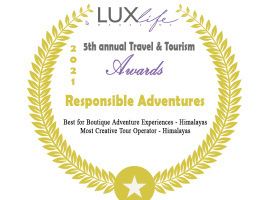Bisket Jatra Festival, Bhaktapur Nepal.
13th April – 14th April 2020
10th April – 18th April 2019
Jatras or Festivals hold an immense religious significance amongst the Newar community of Kathmandu valley. The New communities of Kathmandu, Lalitpur, and Bhaktapur districts celebrate several Jatras devoutly annually.
The Newars of Kathmandu celebrate Indra Jatra as their main Festival, the Newars of Lalitpur celebrate Rato Machindranath Jatra, while the Newars of Bhaktapur observe Bisket and Gai Jatras. Bisket and Gai Jatras are important festivals where thousands of people gather at the Bhaktapur Durbar square to watch these festivals.
The Bisket Jatra is a nine-day festival that falls at the end of the Nepalese month of Chaitra. This Festival signifies the end of a year and the beginning of a new year on the Bikram Sambat calendar. The Jatra’s primary focus is pulling chariots of two deities, namely the Goddess Bhadrakali and the wrathful God Bhairav. The chariots are assembled in the Bhaktapur Durbar square a few days before the event. Then, young locals pull it through the narrow streets of Bhaktapur.
The History of Bisket Jatra
Several historical stories behind the Bisket Jatra relate to the gods and goddesses. One of the many versions of the locals’ stories is snakes, which the Newars of this vicinity widely accept. Thus, Bisket Jatra is also called the “Festival after the serpent’s death.” Various areas of Bhaktapur celebrate this Festival according to their customs.
The Princess and her snakes
King Jagajyoti Malla was fascinated by the folklore and myth about a beautiful princess and her husband’s recurrent deaths. The Princess was bound by a curse that compelled anyone marrying her to die the next day. As a result, many young men lost their lives after marrying the Princess.
Subsequently, a young man was chosen to marry the Princess, despite the worries of his elderly mother. Goddess Bhadrakali came in the guise of another elderly lady and advised the young man to stay awake even after the Princess fell asleep.
The Princess lay in bed and fell asleep quickly after the consummation of the marriage. However, the young man heeded the advice of the elderly lady and stayed awake. He sat beside the Princess and looked at her face. After a while, two venomous serpents crawled out from the nasal of the Princess. The young man killed the snakes quickly with his sword, which freed the Princess from the serpents’ curse.
King Jayajyoti loved this myth so much that he wanted it to be remembered with happiness and joy. So the occasion was initially called Biskyaku Jatra, now known as Bisket Jatra. Bi Syaku means “the snake’s laughter” in the Newari language.
The two serpents and rice grains
Another famous myth about this Festival revolves around the Shidev Kings. The Kirats (an ethnic group of Nepal) attacked, looted, and beat Bhaktapur’s residents when the Shidev Kings ruled over Kathmandu. The King consulted Shekharacharya – a tantric (one who performs black magic), to prevent such attacks. The tantric transformed himself into a tiger and chased out the Kirats.
One day the tantric’s wife wanted to see him in the form of a python, forwarding this request. The tantric gladly obliged and gave her some rice grains to be sprinkled onto him to turn back into his standard form. However, after Shekhararchaya transformed into a python, his wife got petrified and ran away without spraying the rice grains onto the python and ate the rice grains. As a result, she, too, turned into a python. Once the couple realized they had no choice, they took their own lives on the river bank. The kings started to erect the Lingo to commemorate the memory of the unfortunate couple.
There are many more stories on how Bisket Jatra came about. But, despite this, Bhaktapur’s legacy of Bhadrakali’s advice and the two serpents with the rice grains are the most popular among Bhaktapur locals.
The celebration.
Bhaktapur Durbar Square and Thimi are the two central locations where Bisket Jatra is celebrated. The Festival at Durbar Square attracts people from all over the Kathmandu valley. The locals assemble and erect the main chariot of God Bhairav and another for the Goddess Bhadrakali. Bhairava and Bhadrakali are enshrined in their respective chariots a few days before the Nepali new year. They are pulled through the narrow alleys and streets of Bhaktapur by groups of young men.
Another highlight of this Festival is the tug of war between the upper and lower part of this town. Thane – the upper part, and Kone – the lower part, pull the chariots towards their side. The chariot is pulled towards Kalla Tole later.
Sindur (Vermilion) Jatra is celebrated during the Bisket Jatra in Balkumari, Thimi. First, the residents of Thimi gather, pulling their chariots. Then, groups of people gather and bring out thirty-two palanquins called Khats, that consist of various gods. Next, Sindoor powder is showered over the gods’ statues, and the people apply Vermilion onto each other while offering prayer to the gods.
Bode is an ancient Newar town that lies to the East of Kathmandu. They celebrate body piercing during this Festival. A volunteer from the Shrestha clan pierces his tongue with a metal spike and roams around the town’s parts by carrying fire torches on their shoulders.
The Lingo
The Lingo is a pole that people erect during the Bisket Jatra. The tradition of constructing the Lingo was started to celebrate the life of the King’s son-in-law, who survived the wedding night. Two lingos of around fifty-five feet are erected in two different town locations. The pole is brought down the following day in the significance of the beginning of the new year.
Two hands given to the pole symbolize the two serpents of the myth. The hands are covered in red cloth, which represents the snakes. A long banner is hung from the top of the pole to symbolize an ancient mythological battle’s victory.
When the symbolic hands on the Lingo are killed, people feel reassured that the snakes will not kill anyone that year. People come with butter lamps to where the pole is erected to worship both the pole and the snakes.
Another myth is that people worship snakes because the reptile is interconnected to rain and water, helping the agricultural land.
Once the pole is brought down on New Year’s day, the Bisket Festival continues for two more days. The dual chariots are pulled out to Bhaktapur Durbar square’s open area and crash into one another. Young pull the chariots using large ropes and smash the chariots onto one another.
The chariots are then put together to symbolize the successful consummation of the Princess’s marriage and the brave son-in-law who released the serpents’ curse from the King’s daughter.
The last two days of the Festival are followed by traditional music, rallies, and dances that fill up Bhaktapur’s whole area. Thus, Bisket Jatra remains one of the most significant festivals, with the most considerable following of Bhaktapur.

Duration of the Bisket Jatra
This is a nine-day-long festival celebrated by the indigenous Newar community of Bhaktapur. It is located 13 km east of Kathmandu. It has been gaining enormous popularity and enthusiasm in recent times.
This Festival’s dates change on the Gregorian calendar as it follows the lunar calendar, which depends on astrological positions. This Festival always occurs during the end and the beginning of the new year of the Nepalese calendar. The Festival begins five days before the last day of the lunar year and continues until the fourth day of the new year.
Thousands of people from all walks of life and religions venture into Bhaktapur Durbar Square to witness this festival. Yet another myth says anyone who visits the deities and chariots will remain prosperous and happy for the rest of their lives. This Festival is also celebrated to acknowledge gratitude towards The Hindu God of wrath- Bhairav. Prayers and food are offered to the chariot of the Hindu God Bhairav with the hope that their sufferings and problems are kept at bay throughout the future.
You can contact us to experience Bisket Jatra on your visit to Nepal. You will feel the enthusiasm and vitality of this famous Festival.
Check out our Trekking packages for Nepal, Bhutan, India, and Tibet.
















